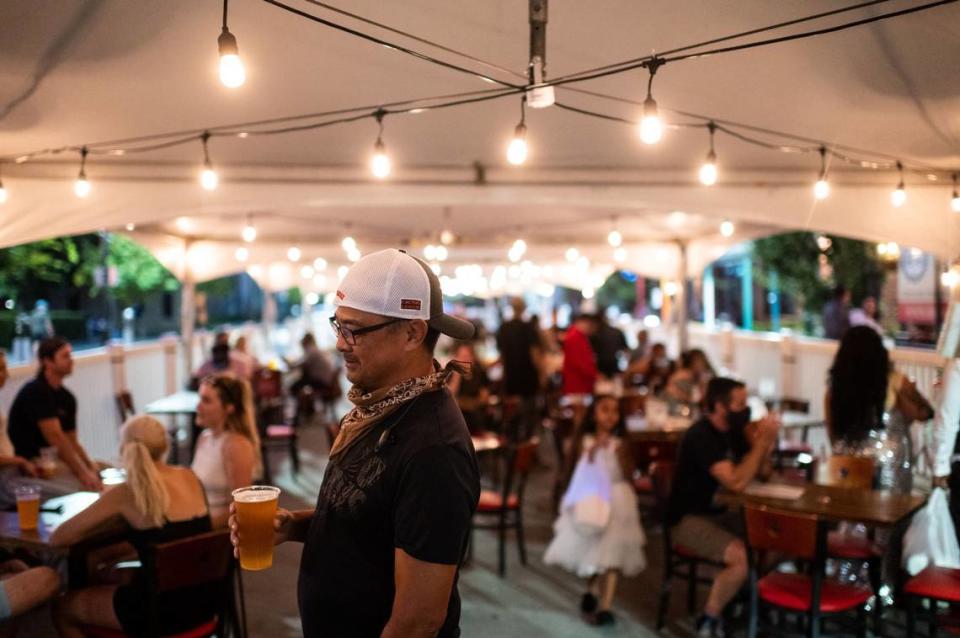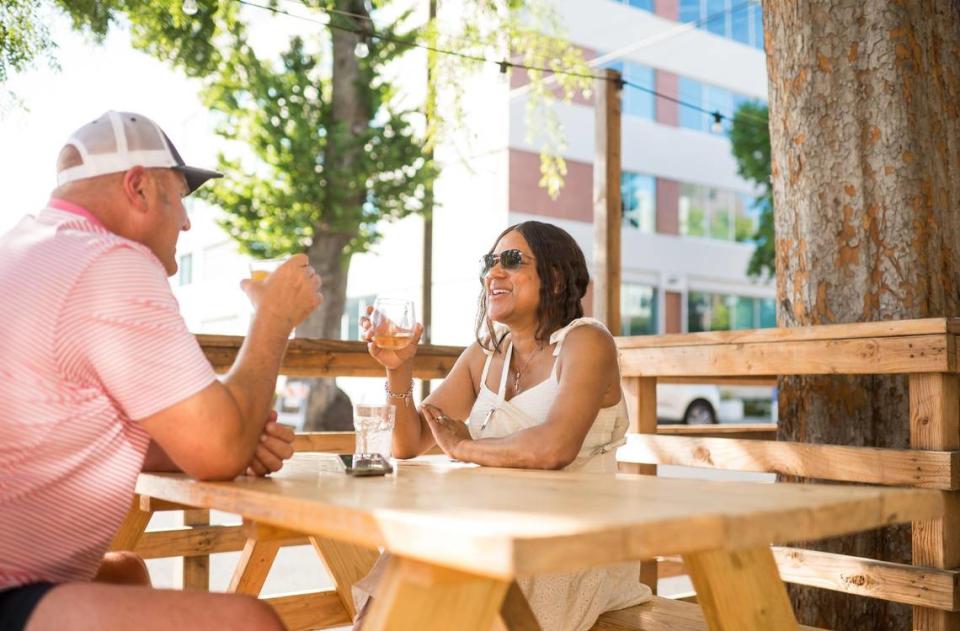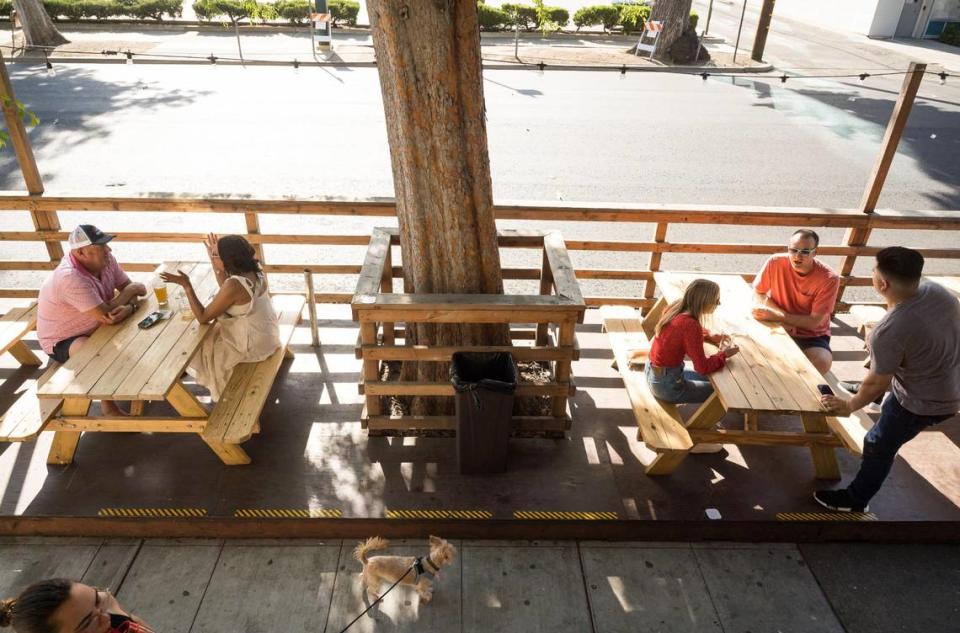Sacramento’s alfresco dining scene has crumbled since the pandemic. Here’s why it’s gone
During the coronavirus pandemic, Rosalyn Livingston drove 25 minutes from her home in Sacramento’s Vineyard neighborhood to eat at Burgers & Brew in the R Street Corridor. And it truly was in the R Street Corridor.
Customers dined at tables in the middle of the entertainment district’s main road, which was closed off to traffic and covered by white tents. It felt like one giant community-oriented event, Livingston said.
“I liked the tent setup and all that kind of stuff because it gives more of a picnic, family-type of vibe. Versus now, it’s more parking, so it’s more crowded, now you (have) more cars,” Livingston said. “Yeah, it’s just different.”
Those tables and tents are nowhere to be seen today. Vehicle traffic once again flows through the R Street Corridor as alfresco dining, a silver lining of the COVID-19 pandemic, has all but vanished.

Sacramento restaurants flowed into sidewalks, parking spaces and even roads during the pandemic. Almost a year ago, though, the city began sunsetting its laissez-faire approach to alfresco dining in favor of a formalized program with additional costs. That’s spelled the end of many pandemic-era patios.
Eighty-five Sacramento restaurants and bars received city Al Fresco dining permits in 2020, according to a Public Records Act request. Fewer than 20 of those setups are still in operation today. Just one development applied for a new Al Fresco dining permit over the past year.
Some restaurants have cut their outdoor dining expansions as the dining populace moved back indoors. But unexpected fees and hurdles have hamstrung the city of Sacramento’s revised Al Fresco program at times, business owners said.
“I think there’s definitely a lot of learning on everyone’s side,” said Renee Funston, development manager for Capitol Area Development Authority, or CADA. “There’s definitely a lot of requirements that we were learning as we were going.”
The program is there, said city of Sacramento parking services director Matt Eierman. Whether businesses take advantage of it is up to them.
“We have put together a robust program that allows easy access for people to put these (concepts) on the street. So if they make a decision to move forward or not move forward, that’s really a personal decision they have,” said Eierman said.
About the Writer
Benjy Egel, a Sacramento native, covers local restaurants and bars for The Bee.
RESHAPING A SUCCESS STORY
Some Sacramento restaurants already had outdoor dining when the pandemic began in March 2020. Within a couple of months, though, they were joined by expedited patios under what was the precursor to the city’s current Al Fresco dining program.
Emergency structures were rapidly constructed, hammered together out of wood or sequestered from city streets by orange plastic barricades. They were often referred to as parklets, though the city is now specifying that term refers to public areas where food and drinks can’t be sold, instead places where restaurants do business.
While these structures got the job done in a pandemic, they needed to become Americans with Disabilities Act-compliant and meet city code requirements to stick around long term. Restaurants would need to retrofit their COVID-era developments to meet permanent Al Fresco dining program requirements, Eierman announced in June 2022.
The permanent program includes six alfresco patio configurations that restaurant owners can choose from, which the business can tweak to serve their needs. There’s only one application form, rather than separate ones for different city departments.
That’s made the re-application process easier for restaurants such as Kupros Craft House, which plans to make its eight-table patio along 21st Street permanent, said co-owner/general manager Keegan Currey.

“The city’s been great to work with, surprisingly so,” Currey said. “Anyone that’s ever tried to get a permit at any given time for anything probably knows the hoops you need to jump through, and they’ve been fairly easy to work with, all things considered. I feel like they’ve done their best to make it as easy on us as possible.”
The initial patio doubled Kupros’ available space during the pandemic and paid for itself, Currey said. Kupros will keep a similar layout but add a roof, feature bar seating along the railings and have electrical lines for fans and heaters.
The cost of a permanent structure will be “night and day” compared to the temporary version, Currey said. But the timing of building a more stable structure aligned with Kupros needing to take down its old patio to make way for city crews to install a new protected bike lane along 21 Street. They see a benefit to the more expensive rebuild.
“It’s well worth it,” Currey said. “Especially when it’s permanent, we can justify a little more expenditure without having to worry about taking it out someday.”
5 of the best restaurants around Sacramento to enjoy outdoor dining this summer
NO FREE LUNCH
The Al Fresco program also carries $2 million in reimbursable grant funding for restaurants, which can receive up to $20,000 apiece on engineering work, construction labor and materials, decor and seating depending on the degree of renovation.
Yet $20,000 won’t cover retrofitting all patios to meet city codes. That’s one reason The Rind is removing its L Street patio, owner Sara Arbabian said, along with the strain it put on her small restaurant’s kitchen staff.
To be compliant with the city’s new requirements, The Rind’s lifted wood patio needed a ramp or wheelchair lift, better drainage and to ensure that their structure didn’t stress the roots of a large tree that sat in the center. It’d cost $30,000-$40,00 to renovate on top of sunk costs, and the wood structure would then need continued maintenance over time, Arbabian said.
“What they think they’re doing is streamlining the process ... but you still need to have architects involved and contractors involved and none of that’s cheap,” Arbabian said. “We’ve already spent (tons) of money on these patios, and now we’re looking at adding more architecture and construction fees.”
The “kicker,” though, was that the city would charge The Rind $600 per month in rent if the restaurant’s patio continued to occupying parking spaces along L Street, Arbabian said. All restaurants with Al Fresco dining will have to pay $25-$100 per month based on their setup.
Customers already pay a 1.5% Handle District tax on all food and nonalcoholic drink purchases to fund city improvements around the neighborhood, plus another 1.5% to fund Measures A and U projects around town. More customers at The Rind, then, would inherently mean more tax dollars in city coffers, Arbabian said.
Eierman called the monthly rent a “recovery cost,” noting that the city hired a staff member to facilitate the Al Fresco program and must fund that position.
Arbabian has instead opted to weatherize The Rind’s other patio, a garden pocket attached to the cheese-oriented restaurant and wine bar that predated the pandemic.
“It’s a question of resources and our long-term game plan,” Arbabian said. “If it wasn’t so expensive we’d say, ‘sure, why not? Why not do a few upgrades to the patio to bring it to code?’ But it’s very, very, very expensive.”
STREETS REOPEN, BUT NOT TO DINERS
When COVID-19 made indoor meals unpalatable, Sacramento restaurants moved their dining rooms outside into public spaces. While weather elements provided some challenges, the Al Fresco program was a lifeline for customers and business owners alike.
Isolated people finally had places to socialize, with minimal risk of virus transmission. Their eagerness to get out helped restaurants recoup some lost revenue, allowing them to bring some furloughed employees back to work.
That included small expansions into sidewalks and parking lots. Most notably, though, the city closed off traffic on entire blocks surrounding restaurants in the R Street Corridor, the Handle District and Curtis Park, where massive tents shaded customers from the summer sun.

Restaurateurs such as Peter Hoey, whose fried chicken spot Bawk spilled out into R Street, easily saw the benefits.
“I like the idea and the European vibe of loads of cafes and restaurants having curbside tables and closing off blocks (for) in-street seating,” Hoey wrote in an email. “That vibe was one of the positives during (C)ovid. It was so much great energy walking around with everyone out in the streets dining and socializing. So much more of a community vibe.”
Cities such as Davis and Mountain View elected to keep major entertainment streets closed to traffic coming out of the pandemic. But all of Sacramento’s pandemic-closed streets have since reopened, though businesses and organizations can still apply to shut them off for events such as farmers markets, Eierman said.
Bawk couldn’t justify investing in an Al Fresco setup without the access to R Street it previously enjoyed, Hoey said. The restaurant’s latest add-on is The Roost, a 48-person indoor speakeasy that’s as out-of-sight as in-street dining was present.
“We looked into it but it didn’t make sense to pursue — the cost of the parklet construction was too high to justify gaining (three) or (four) more tables for service so it wasn’t something we really spent any time on,” Hoey wrote in an email. “It would take shutting down the whole street again so we could gain 10-20 more tables to be worth doing and I am not sure the city is interested in closing R Street again, but we haven’t really pushed it with them either.”
WHEN IT WORKS
Ace’s Gyro Shack and Cafe Xocolatl opened within the last six months, joining longstanding Capital lunch spot Yummy Choice in a building at the corner of 10th and P streets in downtown Sacramento.
Together with property manager Capitol Area Development Authority, or CADA, these restaurants are pioneering the modern Al Fresco dining setup. As of late April, the property at 10th and P was the first and only to receive a new Al Fresco permit since the program overhaul was announced in June 2022.
“With CADA’s experience, we know how to work through the city’s permitting process. I would think that would be kind of complicated for any regular, average business owner that doesn’t do that kind of work, so I think as we can help make the process more streamlined and clear for people ... the better,” said Funston, the firm’s development manager.
CADA had been planning a larger renovation to its 10th Street properties since October 2021, Funston said. As such, its new Al Fresco setup integrates better into its surroundings than many of the more rushed pandemic-era projects.
There are no plastic barricades; instead, a curb simply juts out farther into 10th Street. Two lunch counters with leaf patterns across their metal undercarriages face Roosevelt Park’s softball fields next to a pair of plastic tables and bike racks.
The project cost CADA more than $63,000 in total. But Ace’s, Yummy Choice and Cafe Xocolatl don’t have much indoor seating, and CADA wanted to beautify its corner of downtown Sacramento.
“It just makes our community better,” Funston said. “The more activity we have and the more eyes in the street, the safer and more lively our communities are.”


